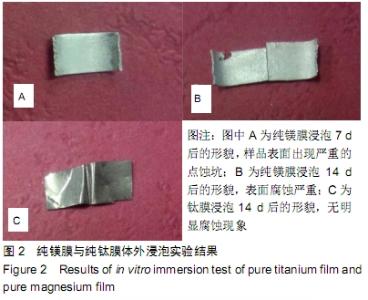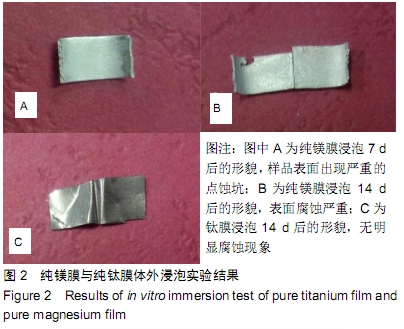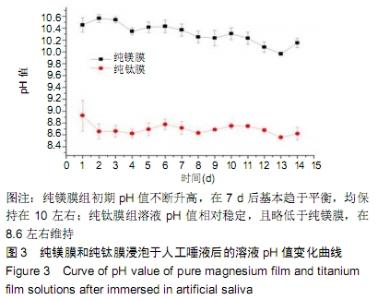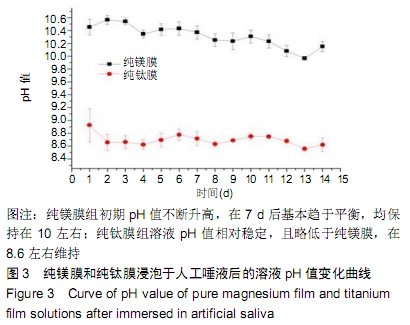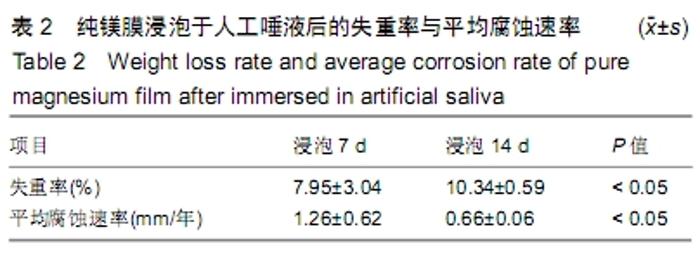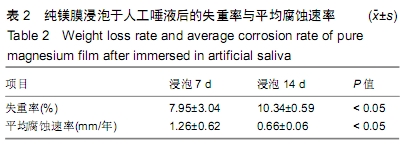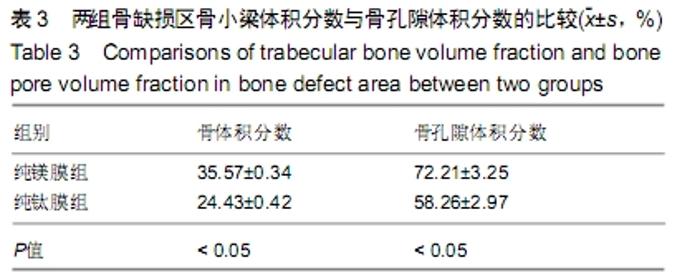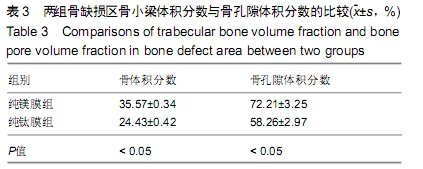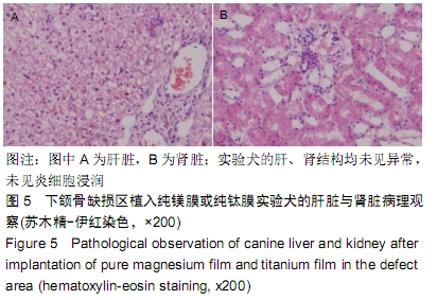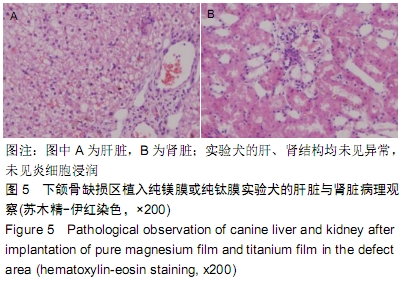Chinese Journal of Tissue Engineering Research ›› 2020, Vol. 24 ›› Issue (16): 2578-2584.doi: 10.3969/j.issn.2095-4344.2253
Previous Articles Next Articles
In vitro corrosion and in vivo biosafety of pure magnesium film
Sun Xirao1, Wang Chengyue1, Zhao Yuan2, Zhang Zhenbao1
- 1Second Affiliated Hospital of Jinzhou Medical University, Jinzhou 121000, Liaoning Province, China; 2Jinzhou Stomatological Hospital, Jinzhou 121000, Liaoning Province, China
-
Received:2019-09-17Revised:2019-09-18Accepted:2019-10-31Online:2020-06-08Published:2020-03-26 -
About author:Sun Xirao, Master, Attending physician, the Second Affiliated Hospital of Jinzhou Medical University, Jinzhou 121000, Liaoning Province, China -
Supported by:the Natural Science Foundation of Liaoning Province (Key Project), No. 20180530071; the Natural Science Foundation of Liaoning Province, No. 2019-MS-141
CLC Number:
Cite this article
Sun Xirao, Wang Chengyue, Zhao Yuan, Zhang Zhenbao. In vitro corrosion and in vivo biosafety of pure magnesium film[J]. Chinese Journal of Tissue Engineering Research, 2020, 24(16): 2578-2584.
share this article
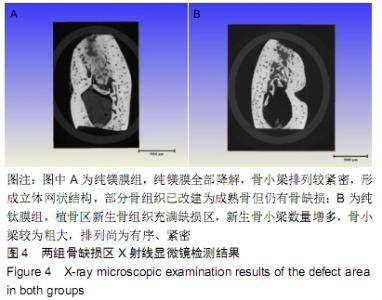
2.2 体内动物实验结果 2.2.1 大体观察结果 所有实验犬生存状态良好,术后首日状态显著低迷,几日后恢复正常,进食均良好。未见材料暴露及创口感染,各实验犬手术创口均为一期愈合。术后12周,纯镁膜组植骨区外形塌陷,质地尚可;纯钛膜组植骨区外形轮廓较饱满,质地坚硬。 2.2.2 X射线显微镜检测结果 术后12周,两组实验区域X射线显微镜检测可见骨断面呈现多孔立体网状结构,骨缺损区被新生骨小梁充填;纯镁膜组纯镁膜全部降解,骨小梁排列较紧密,形成立体网状结构,部分骨组织已改建为成熟骨但仍有骨缺损;纯钛膜组植骨区新生骨组织充满缺损区,新生骨小梁数量增多,骨小梁较为粗大,排列尚为有序、紧密,见图4。纯镁膜组的骨体积分数、骨孔隙体积分数明显高于纯钛膜组(P < 0.05),见表3。 "
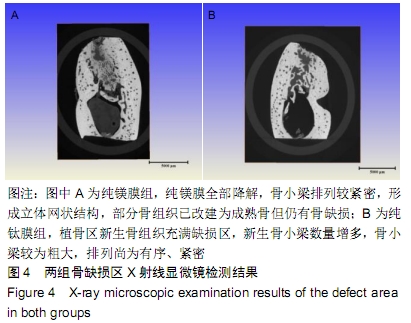
| [1] ELGALI I, OMAR O, DAHLIN C, et al.Guided bone regeneration: materials and biological mechanisms revisited.Eur J Oral Sci. 2017;125(5):315-337. [2] GUARNIERI R, STEFANELLI L, DE ANGELIS F, et al. Extraction Socket Preservation Using Porcine-Derived Collagen Membrane Alone or Associated with Porcine-Derived Bone. Clinical Results of Randomized Controlled Study.J Oral Maxillofac Res. 2017;8(3):e5. [3] YAMASAKI Y, YOSHIDA Y, OKAZAKI M, et al.Action of FGMgCO3Ap-collagen composite in promoting bone formation.Biomaterials.2003;24(27):4913-4920. [4] GUTTA R, BAKER RA, BARTOLUCCI AA, et al.Barrier membranes used for ridge augmentation: is there an optimal pore size?.J Oral Maxillofac Surg.2009;67(6):1218-1225. [5] YAMANO S, HAKU K, YAMANAKA T, et al.The effect of a bioactive collagen membrane releasing PDGF or GDF-5 on bone regeneration.Biomaterials.2014;35(8):2446-2453. [6] SARDARIAN A, DANAEI SM, SHAHIDI S, et al.The effect of vertical bracket positioning on torque and the resultant stress in the periodontal ligament--a finite element study.Prog Orthod. 2014;15:50. [7] PARODI R, CARUSI G, SANTARELLI G, et al.Implant placement in large edentulous ridges expanded by GBR using a bioresorbable collagen membrane.Int J Periodontics Restorative Dent.1998;18(3):266. [8] MONTERO E, WESSING B, URBAN I, et al.Randomized clinical trial: a resorbable collagen membrane for GBR at sites with dehiscence defects.Clin Oral Implants Res. 2017;28:402-402. [9] YU W,ZHAO H,DING Z,et al.In vitro and in vivo evaluation of MgF2 coated AZ31 magnesium alloy porous scaffolds for bone regeneration.Colloids Surf B Biointerfaces. 2017;149:330-340. [10] PENG W,CHEN JX,SHAN XF,et al.Mg-based absorbable membrane for guided bone regeneration (GBR): a pilot study.Rare Metals.2019;(6):1-11. [11] 白阳.镁合金膜引导骨再生修复重度萎缩下颌牙槽骨的实验研究[D].北京:中国人民解放军医学院,2013. [12] 王亮,郭玉兴,黄华,等.颌骨缺损修复用多孔镁合金支架材料的生物安全性评价研究[J].中国组织工程研究, 2019,23(26):4121-4128. [13] ZHANG S,ZHANG X,ZHAO C,et al. Research on an Mg-Zn alloy as a degradable biomaterial.Acta Biomater. 2010;6(2): 626-640. [14] PARK RS, KIM YK, LEE SJ, et al.Corrosion behavior and cytotoxicity of Mg-35Zn-3Ca alloy for surface modified biodegradable implant material.J Biomed Mater Res B Appl Biomater.2012;100B(4):911-923. [15] 张佳,宗阳,袁广银,等.新型医用Mg-Nd-Zn-Zr镁合金在模拟体液中的降解行为[J].中国有色金属学报,2010,20(10):1989-1997. [16] 李春梅,卫中领,王增辉,等.镁合金在人工血浆中的降解规律与可控降解途径[C].2009年全国电子电镀及表面处理学术交流会论文集,2009. [17] LI QT, YE WB, GAO H, et al.Improving the corrosion resistance of ZEK100 magnesium alloy by combining high-pressure torsion technology with hydroxyapatite coating.Mater Design. 2019;181:107933. [18] WANG Y, PENG GC, ZHANG SG, et al.The fabrication of a CeO2 coating via cathode plasma electrolytic deposition for the corrosion resistance of AZ31 magnesium alloy.Ceram Int.2018;44(16):19885-19891. [19] 陈宏,王成成,康亚斌,等.镁合金微弧氧化的研究现状[J].表面技术,2019,48(7):49-60. [20] HERMAWAN H. Updates on the research and development of absorbable metals for biomedical applications.Prog Biomater. 2018;7(2):93-110. [21] MOSTAED E, SIKORA-JASINSKA M, DRELICH JW, et al. Zinc-based alloysfor degradable vascular stent applications. Acta Biomater.2018;71:1-23. [22] MAO L, SHEN L, CHEN J, et al.Enhanced bioactivity of Mg-Nd-Zn-Zr alloy achieved with nanoscale MgF2 surface for vascular stent application.ACS Appl Mater Interfaces. 2015; 7(9):5320-5330. [23] LEE JK, HA SH, KIM YJ, et al.Melt Protection Property and Ignition Resistance Property of CaO added AZ91D Mg Alloy.J Korea Foundry Soc.2007;27(3):131-134. [24] 刘明达,段峰,李慕勤,等.纯镁超声微弧氧化-NaOH-硅烷-丝素复合处理膜层的细胞相容性[J].中国体视学与图像分析, 2016, 21(2):206-212. [25] LINSHENG L, GUOXIANG L, LIHUI L.Research on the preparation, biocompatibility and bioactivity of magnesium matrix hydroxyapatite composite material.Biomed Mater Eng. 2016;27(2-3):251-258. [26] 任伊宾,黄晶晶,杨柯,等.纯镁的生物腐蚀研究[J].金属学报,2005, 41(11):1228-1232. [27] WANG Y, ZHU Z, HE Y, et al.In vivo degradation behavior and biocompatibility of Mg-Nd-Zn-Zr alloy at early stage.Int J Mol Med.2012;29(2):178-184. [28] ZHEN L, SUN S, CHEN M, et al.In vitro and in vivo corrosion, mechanical properties and biocompatibility evaluation of MgF2-coated Mg-Zn-Zr alloy as cancellous screws.Mater Sci Eng C Mater Biol Appl.2017;75:1268-1280. [29] QIU X, WAN P, TAN L, et al.Preliminary research on a novel bioactive silicon doped calcium phosphate coating on AZ31 magnesium alloy via electrodeposition.Mater Sci Eng C Mater Biol Appl.2014;36:65-76. [30] GUAN X, XIONG M, ZENG F, et al.Enhancementof Osteogenesis and Biodegradation Controlby Brushite Coating on Mg–Nd–Zn–Zr Alloy forMandibular Bone Repair.ACS Appl Mater Interfaces.2014;6(23):21525-21533. [31] ZHANG N, LIU N, SUN C, et al. In vivo study of a novel micro-arc oxidation coated magnesium-zinc-calcium alloy scaffold/autologous bone particles repairing critical size bone defect in rabbit.Zhongguo Xiu Fu Chong Jian Wai Ke Za Zhi. 2018;32(3):298-305. [32] HONG D, CHOU DT, VELIKOKHATNYI OI, et al.Binder-jetting 3D printing and alloy development of new biodegradable Fe-Mn-Ca/Mg alloys.Acta Biomater.2016;45:375-386. [33] SAMEER KUMAR D, TARA SASANKA C, RAVINDRA K, et al. Magnesium and Its Alloys in Automotive Applications -A Review. J Mater Sci Technol.2015;4:12-30. [34] ALVAREZ-LOPEZ M, PEREDA MD, DEL VALLE JA, et al. Corrosion behaviour of AZ31 magnesium alloy with different grain sizes in simulated biological fluids.Acta Biomater. 2010; 6(5):1763-1771. [35] XU L, YU G, ZHANG E, et al.In vivo corrosion behavior of Mg-Mn-Zn alloy for bone implant application.J Biomed Mater Res A.2010;83A(3):703-711. [36] HORT N, HUANG Y, FECHNER D, et al.Magnesium alloys as implant materials– Principles of property design for Mg–RE alloys.Acta Biomater.2010;6(5):1714-1725. [37] WITTE F, FISCHER J, NELLESEN J, et al.In vitro and in vivo corrosion measurements of magnesium alloys. Biomaterials. 2006;27(7):1013-1018. [38] 刘通.医用镁合金生物降解行为研究[D].广州:华南理工大学, 2011. [39] 陈玲玲,顾艳红,窦艳涛,等.生物可降解镁合金的体外腐蚀评价方法[J].材料保护,2014,47(4):51-56. [40] 武波.医用镁合金体液腐蚀与磨损性能研究[D].天津:天津理工大学,2013. [41] WITTE F, FEYERABEND F, MAIER P, et al.Biodegradable magnesium–hydroxyapatite metal matrix composites. Biomaterials.2007;28(13):2163-2174. [42] WINDHAGEN H, RADTKE K, WEIZBAUER A, et al. Biodegradable magnesium-based screw clinically equivalent to titanium screw in hallux valgus surgery: Short term results of the first prospective, randomized, controlled clinical pilot study.Biomed Eng Online.2013;12(1):62. [43] PAN Y, HE S, WANG D, et al.In vitro degradation and electrochemical corrosion evaluations of microarc oxidized pure Mg, Mg-Ca and Mg-Ca-Zn alloys for biomedical applications.Mater Sci Eng C Mater Biol Appl.2015;47:85-96. [44] MARCO I, MYRISSA A, MARTINELLI E, et al.In vivo and in vitro degradation comparison of pure Mg, Mg-10Gd and Mg-2Ag: a short term study.Eur Cell Mater.2017;33:90. [45] HOU P, ZHAO C, CHENG P, et al.Reduced antibacterial property of metallic magnesium in vivo.Biomed Mater. 2016; 12(1):015010. [46] 叶勇,李军,荆珏华.钛板与弹性髓内钉修复锁骨中段骨折的Meta分析[J].中国组织工程研究,2016,20(26):3938-3945. [47] GANELES J, WISMEIJER D.Early and immediately restored and loaded dental implants for single-tooth and partial-arch applications.Int J Oral Maxillofac Implants.2004;19 Suppl(1): 92. [48] 陈钢,李树春,马练,等.应用钛膜及胶原膜治疗种植体周骨缺损的比较研究[J].中国口腔种植学杂志, 2005,10(3):105-107, 120-155. [49] 李雁,马国武,吉东.GBR修复种植体周骨缺损的组织学研究[J].中国现代药物应用,2016,10(22):197-198. [50] DEGIDI M, SCARANO A, PIATTELLI A.Regeneration of the alveolar crest using titanium micromesh with autologous bone and a resorbable membrane.J Oral Implantol. 2003;29(2): 86-90. [51] GAO JC, QIAO LY, XIN RL. Effect of Mg2+ concentrationon biocompatibility of pure magnesium.Front Mater Sci China. 2010;4(2):126-131. [52] ZHANG EL, YIN DS, XU LP, et al.Microstructure, mechanical and corrosion properties and biocompatibility of Mg-Zn-Mn alloys for biomedical application. Mat Sci Eng C-Mater. 2009; 9(3):987-993. |
| [1] | Li Xinping, Cui Qiuju, Zeng Shuguang, Ran Gaoying, Zhang Zhaoqiang, Liu Xianwen, Fang Wei, Xu Shuaimei. Effect of modification of β-tricalcium phosphate/chitosan hydrogel on growth and mineralization of dental pulp stem cells [J]. Chinese Journal of Tissue Engineering Research, 2021, 25(22): 3493-3499. |
| [2] | Liu Liyong, Zhou Lei. Research and development status and development trend of hydrogel in tissue engineering based on patent information [J]. Chinese Journal of Tissue Engineering Research, 2021, 25(22): 3527-3533. |
| [3] | Ma Qing, Shi Liyan, Huang Sixue, Zheng Zhangbowen, Zhang Aihua, Zhan Desong, Fu Jiale. Research status and prospect of zirconia ceramics in dental prosthesis [J]. Chinese Journal of Tissue Engineering Research, 2021, 25(22): 3597-3602. |
| [4] | Wen Zhijing, Gu Pengzhen, He Xijing, Li Jialiang, Wang Yibin, Wang Yiqun. Development of high molecular polymer polyetherketoneketone and its prospects in medical applications [J]. Chinese Journal of Tissue Engineering Research, 2021, 25(22): 3603-3608. |
| [5] | Chen Siqi, Xian Debin, Xu Rongsheng, Qin Zhongjie, Zhang Lei, Xia Delin. Effects of bone marrow mesenchymal stem cells and human umbilical vein endothelial cells combined with hydroxyapatite-tricalcium phosphate scaffolds on early angiogenesis in skull defect repair in rats [J]. Chinese Journal of Tissue Engineering Research, 2021, 25(22): 3458-3465. |
| [6] | Chen Siyu, Li Yannan, Xie Liying, Liu Siqi, Fan Yurong, Fang Changxing, Zhang Xin, Quan Jiayu, Zuo Lin. Thermosensitive chitosan-collagen composite hydrogel loaded with basic fibroblast growth factor retards ventricular remodeling after myocardial infarction in mice [J]. Chinese Journal of Tissue Engineering Research, 2021, 25(16): 2472-2478. |
| [7] | Li Jie, Xu Jianzhen, Hu Ping, Lei Qiqi, Zhang Wenning, Ao Ningjian . Preparation and performance evaluation of carboxymethyl chitosan/oxidized glucomannan/Panax notoginseng compound sponge dressing for chronic wound [J]. Chinese Journal of Tissue Engineering Research, 2021, 25(16): 2528-2534. |
| [8] | Li Yanle, Yue Xiaohua, Nie Zhen, Zhang Junwei, Li Zhaohui, Nie Weizhi, Jiang Hongjiang. Characteristics and application of bioabsorbable materials in orthopedics [J]. Chinese Journal of Tissue Engineering Research, 2021, 25(16): 2612-2617. |
| [9] | Xu Changkui, Pu Xiaobing, Lu Yao, Chen Jiarong, Pan Lei. Safety and antibacterial properties of gentamicin-loaded silk fibroin in meniscus repair [J]. Chinese Journal of Tissue Engineering Research, 2021, 25(10): 1545-1549. |
| [10] | Tang Jingfeng, Zhang Jun, You Qi, Liu Yi. The role and mechanism of graphene and its derivatives-related composites in cartilage repair [J]. Chinese Journal of Tissue Engineering Research, 2020, 24(4): 619-624. |
| [11] | Liu Haiyan, Hu Yang, Wu Xiuping, Pan Haobo, Jing Xuan. Chitosan-based polysaccharide biomaterial for prevention and treatment of oral diseases [J]. Chinese Journal of Tissue Engineering Research, 2020, 24(4): 631-636. |
| [12] | Lei Senlin, Liu Hongyuan, Yang Hongsheng, Xiong Yan, Duan Hong. In vivo biosafety and histocompatibility of absorbable poly-D,L-lactic acid screws implanted with ultrasound-assisted technology [J]. Chinese Journal of Tissue Engineering Research, 2020, 24(34): 5454-5460. |
| [13] | Liu Fei, Zhang Guanxin, Liu Xiaohong, Wang Licheng, Xu Zhiyun. Endothelialization of acellular scaffold from sterilized bovine pericardium [J]. Chinese Journal of Tissue Engineering Research, 2020, 24(28): 4562-4566. |
| [14] | Ji Haihong, Dong Qiang. Finite element analysis of different fixation methods for mandibular defects reconstructing with fibula flaps [J]. Chinese Journal of Tissue Engineering Research, 2020, 24(24): 3821-3827. |
| [15] | Sun Xirao, Sun Baozhai, Zhang Zhenbao. Combination of magnesium ion with mineralized collagen intervenes osteogenic differentiation of mouse preosteoblasts [J]. Chinese Journal of Tissue Engineering Research, 2020, 24(22): 3467-3473. |
| Viewed | ||||||
|
Full text |
|
|||||
|
Abstract |
|
|||||
